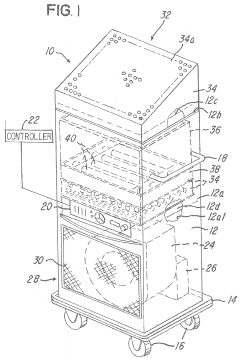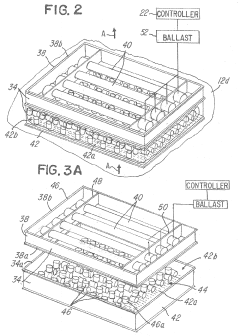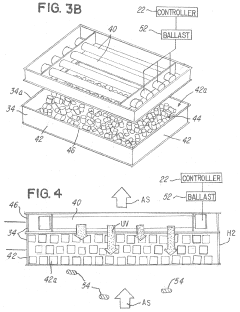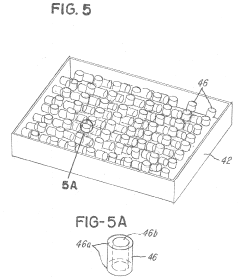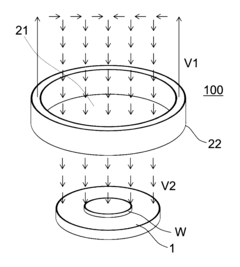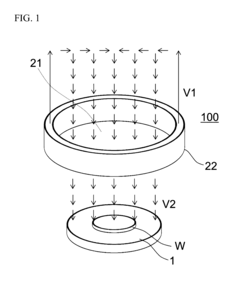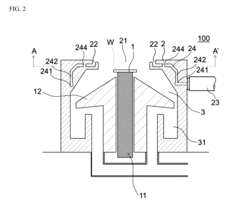Laminar Flow Solutions for Air Quality Enhancement
JUL 10, 20259 MIN READ
Generate Your Research Report Instantly with AI Agent
Patsnap Eureka helps you evaluate technical feasibility & market potential.
Laminar Flow Technology Background and Objectives
Laminar flow technology has emerged as a promising solution for enhancing air quality in various environments. The concept of laminar flow originated in fluid dynamics, where it describes a fluid moving in parallel layers without disruption. In the context of air quality enhancement, laminar flow technology aims to create a controlled, unidirectional airflow that minimizes turbulence and effectively removes airborne contaminants.
The development of laminar flow technology for air quality improvement can be traced back to the mid-20th century, with initial applications in clean rooms and healthcare facilities. Over the years, the technology has evolved significantly, driven by advancements in fluid dynamics, materials science, and computational modeling. Today, laminar flow solutions are being explored for a wide range of applications, including residential and commercial buildings, industrial settings, and public spaces.
The primary objective of research in laminar flow solutions for air quality enhancement is to develop more efficient, cost-effective, and adaptable systems that can effectively remove particulate matter, volatile organic compounds (VOCs), and other airborne pollutants. This involves optimizing airflow patterns, improving filtration mechanisms, and integrating smart control systems to create a more responsive and energy-efficient air quality management solution.
One of the key challenges in this field is balancing the need for effective contaminant removal with energy efficiency and user comfort. Traditional air purification systems often rely on high-velocity airflow, which can be energy-intensive and create uncomfortable drafts. Laminar flow technology seeks to address these issues by creating a more gentle, controlled airflow that can achieve similar or superior air quality outcomes with lower energy consumption and improved occupant comfort.
Another important aspect of laminar flow research is the development of scalable solutions that can be applied to various spatial configurations and environmental conditions. This includes investigating how laminar flow principles can be effectively implemented in both small, enclosed spaces and larger, open areas, as well as adapting the technology to different climatic conditions and pollution profiles.
As air quality concerns continue to grow globally, the potential impact of advanced laminar flow solutions extends beyond indoor environments. Researchers are exploring how this technology can be applied to outdoor air quality management, such as in urban areas with high pollution levels or in industrial zones where localized air quality improvement is crucial.
In conclusion, the research on laminar flow solutions for air quality enhancement aims to revolutionize how we approach air purification and ventilation. By leveraging the principles of laminar flow, scientists and engineers are working towards creating more effective, efficient, and versatile air quality management systems that can significantly improve public health and well-being across various settings.
The development of laminar flow technology for air quality improvement can be traced back to the mid-20th century, with initial applications in clean rooms and healthcare facilities. Over the years, the technology has evolved significantly, driven by advancements in fluid dynamics, materials science, and computational modeling. Today, laminar flow solutions are being explored for a wide range of applications, including residential and commercial buildings, industrial settings, and public spaces.
The primary objective of research in laminar flow solutions for air quality enhancement is to develop more efficient, cost-effective, and adaptable systems that can effectively remove particulate matter, volatile organic compounds (VOCs), and other airborne pollutants. This involves optimizing airflow patterns, improving filtration mechanisms, and integrating smart control systems to create a more responsive and energy-efficient air quality management solution.
One of the key challenges in this field is balancing the need for effective contaminant removal with energy efficiency and user comfort. Traditional air purification systems often rely on high-velocity airflow, which can be energy-intensive and create uncomfortable drafts. Laminar flow technology seeks to address these issues by creating a more gentle, controlled airflow that can achieve similar or superior air quality outcomes with lower energy consumption and improved occupant comfort.
Another important aspect of laminar flow research is the development of scalable solutions that can be applied to various spatial configurations and environmental conditions. This includes investigating how laminar flow principles can be effectively implemented in both small, enclosed spaces and larger, open areas, as well as adapting the technology to different climatic conditions and pollution profiles.
As air quality concerns continue to grow globally, the potential impact of advanced laminar flow solutions extends beyond indoor environments. Researchers are exploring how this technology can be applied to outdoor air quality management, such as in urban areas with high pollution levels or in industrial zones where localized air quality improvement is crucial.
In conclusion, the research on laminar flow solutions for air quality enhancement aims to revolutionize how we approach air purification and ventilation. By leveraging the principles of laminar flow, scientists and engineers are working towards creating more effective, efficient, and versatile air quality management systems that can significantly improve public health and well-being across various settings.
Air Quality Market Demand Analysis
The global air quality market has been experiencing significant growth due to increasing awareness of the health impacts of air pollution and stringent environmental regulations. The demand for laminar flow solutions in air quality enhancement is driven by the need for cleaner air in various sectors, including healthcare, manufacturing, and residential spaces.
In the healthcare sector, laminar flow systems are crucial for maintaining sterile environments in operating rooms, laboratories, and pharmaceutical manufacturing facilities. The COVID-19 pandemic has further emphasized the importance of clean air in healthcare settings, leading to increased investment in advanced air purification technologies. Hospitals and clinics are increasingly adopting laminar flow solutions to reduce the risk of airborne infections and improve overall air quality for patients and staff.
The industrial sector, particularly in manufacturing and cleanroom environments, represents another significant market for laminar flow technologies. Industries such as electronics, aerospace, and biotechnology require ultra-clean environments to ensure product quality and safety. As these industries continue to grow and expand globally, the demand for efficient air quality enhancement solutions is expected to rise correspondingly.
In the residential sector, there is a growing trend towards smart homes and indoor air quality management systems. Consumers are becoming more aware of the health risks associated with poor indoor air quality, leading to increased demand for advanced air purification technologies, including those based on laminar flow principles. This trend is particularly pronounced in urban areas with high pollution levels and in regions prone to wildfires or other environmental hazards.
The automotive industry is also emerging as a potential growth area for laminar flow solutions. As vehicle manufacturers focus on improving in-cabin air quality, there is increasing interest in incorporating advanced air filtration and circulation systems based on laminar flow principles. This trend is expected to accelerate with the rise of electric vehicles and autonomous driving technologies, which place greater emphasis on passenger comfort and well-being.
Geographically, the Asia-Pacific region is expected to witness the highest growth in the air quality market, driven by rapid industrialization, urbanization, and increasing environmental concerns in countries like China and India. North America and Europe continue to be significant markets, with a focus on technological advancements and stringent air quality regulations.
The market for laminar flow solutions in air quality enhancement is characterized by ongoing technological innovations, such as the integration of IoT and AI for smart air quality management. These advancements are expected to drive market growth and create new opportunities for companies operating in this space.
In the healthcare sector, laminar flow systems are crucial for maintaining sterile environments in operating rooms, laboratories, and pharmaceutical manufacturing facilities. The COVID-19 pandemic has further emphasized the importance of clean air in healthcare settings, leading to increased investment in advanced air purification technologies. Hospitals and clinics are increasingly adopting laminar flow solutions to reduce the risk of airborne infections and improve overall air quality for patients and staff.
The industrial sector, particularly in manufacturing and cleanroom environments, represents another significant market for laminar flow technologies. Industries such as electronics, aerospace, and biotechnology require ultra-clean environments to ensure product quality and safety. As these industries continue to grow and expand globally, the demand for efficient air quality enhancement solutions is expected to rise correspondingly.
In the residential sector, there is a growing trend towards smart homes and indoor air quality management systems. Consumers are becoming more aware of the health risks associated with poor indoor air quality, leading to increased demand for advanced air purification technologies, including those based on laminar flow principles. This trend is particularly pronounced in urban areas with high pollution levels and in regions prone to wildfires or other environmental hazards.
The automotive industry is also emerging as a potential growth area for laminar flow solutions. As vehicle manufacturers focus on improving in-cabin air quality, there is increasing interest in incorporating advanced air filtration and circulation systems based on laminar flow principles. This trend is expected to accelerate with the rise of electric vehicles and autonomous driving technologies, which place greater emphasis on passenger comfort and well-being.
Geographically, the Asia-Pacific region is expected to witness the highest growth in the air quality market, driven by rapid industrialization, urbanization, and increasing environmental concerns in countries like China and India. North America and Europe continue to be significant markets, with a focus on technological advancements and stringent air quality regulations.
The market for laminar flow solutions in air quality enhancement is characterized by ongoing technological innovations, such as the integration of IoT and AI for smart air quality management. These advancements are expected to drive market growth and create new opportunities for companies operating in this space.
Current Laminar Flow Challenges
Laminar flow technology, while promising for air quality enhancement, faces several significant challenges in its current state of development and implementation. One of the primary obstacles is the difficulty in maintaining stable laminar flow conditions in real-world environments. Unlike controlled laboratory settings, actual indoor spaces are subject to various disturbances such as human movement, temperature fluctuations, and air currents from HVAC systems. These factors can disrupt the delicate balance required for laminar flow, reducing its effectiveness in air purification.
Another challenge lies in the energy efficiency of laminar flow systems. Creating and maintaining laminar flow often requires substantial energy input, which can lead to increased operational costs and potentially offset the environmental benefits of improved air quality. This energy consumption issue is particularly pronounced in larger spaces or in applications requiring continuous operation, making it a significant hurdle for widespread adoption.
The scalability of laminar flow solutions presents an additional challenge. While the technology may be effective in small, controlled environments, scaling it up for larger spaces such as office buildings, shopping malls, or industrial facilities proves to be complex. The increased volume and varied architectural layouts of these spaces make it difficult to achieve uniform laminar flow throughout, potentially leading to inconsistent air quality improvements.
Furthermore, the integration of laminar flow systems with existing building infrastructure poses significant challenges. Retrofitting older buildings with laminar flow technology can be costly and disruptive, often requiring extensive modifications to ventilation systems and interior layouts. This integration challenge limits the technology's applicability in many existing structures, constraining its potential for widespread implementation.
The cost-effectiveness of laminar flow solutions is another critical challenge. The initial investment for high-quality laminar flow systems, coupled with ongoing maintenance and energy costs, can be prohibitive for many potential users. This economic barrier is particularly significant for small businesses and residential applications, where the perceived benefits may not justify the financial outlay.
Lastly, there is a challenge in optimizing laminar flow for different types of airborne contaminants. While laminar flow can be effective for certain particles and pollutants, its efficiency varies depending on the size, weight, and behavior of different airborne substances. Developing a system that can effectively address a wide range of air quality issues while maintaining laminar flow conditions remains a significant technical challenge in the field.
Another challenge lies in the energy efficiency of laminar flow systems. Creating and maintaining laminar flow often requires substantial energy input, which can lead to increased operational costs and potentially offset the environmental benefits of improved air quality. This energy consumption issue is particularly pronounced in larger spaces or in applications requiring continuous operation, making it a significant hurdle for widespread adoption.
The scalability of laminar flow solutions presents an additional challenge. While the technology may be effective in small, controlled environments, scaling it up for larger spaces such as office buildings, shopping malls, or industrial facilities proves to be complex. The increased volume and varied architectural layouts of these spaces make it difficult to achieve uniform laminar flow throughout, potentially leading to inconsistent air quality improvements.
Furthermore, the integration of laminar flow systems with existing building infrastructure poses significant challenges. Retrofitting older buildings with laminar flow technology can be costly and disruptive, often requiring extensive modifications to ventilation systems and interior layouts. This integration challenge limits the technology's applicability in many existing structures, constraining its potential for widespread implementation.
The cost-effectiveness of laminar flow solutions is another critical challenge. The initial investment for high-quality laminar flow systems, coupled with ongoing maintenance and energy costs, can be prohibitive for many potential users. This economic barrier is particularly significant for small businesses and residential applications, where the perceived benefits may not justify the financial outlay.
Lastly, there is a challenge in optimizing laminar flow for different types of airborne contaminants. While laminar flow can be effective for certain particles and pollutants, its efficiency varies depending on the size, weight, and behavior of different airborne substances. Developing a system that can effectively address a wide range of air quality issues while maintaining laminar flow conditions remains a significant technical challenge in the field.
Existing Laminar Flow Solutions
01 Laminar flow air purification systems
These systems utilize laminar airflow to create a clean air environment, often used in cleanrooms and medical facilities. The laminar flow helps to remove particles and contaminants from the air, improving overall air quality. These systems typically involve specialized filters and air handling units to maintain a consistent, unidirectional airflow.- Laminar flow air purification systems: These systems utilize laminar airflow to create a clean air environment, often used in sensitive areas like cleanrooms or medical facilities. The laminar flow helps to minimize turbulence and maintain a consistent flow of filtered air, reducing the presence of airborne contaminants and improving overall air quality.
- Air quality monitoring in laminar flow environments: Specialized sensors and monitoring systems are employed to assess air quality in laminar flow environments. These devices can measure particle counts, gas concentrations, and other air quality parameters to ensure the effectiveness of the laminar flow system and maintain optimal air quality conditions.
- Laminar flow HVAC systems for improved air quality: HVAC systems designed to produce laminar airflow can significantly enhance indoor air quality. These systems often incorporate advanced filtration methods and precise airflow control to create a more uniform distribution of clean air throughout a space, reducing the concentration of pollutants and allergens.
- Laminar flow solutions for industrial air quality control: In industrial settings, laminar flow technologies are applied to control air quality and manage emissions. These solutions may include specialized ventilation systems, fume hoods, or air curtains that use laminar flow principles to contain and remove airborne contaminants, improving workplace air quality and safety.
- Portable laminar flow devices for personal air quality: Compact, portable devices utilizing laminar flow technology are being developed to provide localized clean air zones for individual use. These personal air purifiers create a small-scale laminar flow field around the user, offering improved air quality in various environments such as offices, public transportation, or outdoor spaces.
02 Laminar flow control in HVAC systems
This approach focuses on optimizing airflow in heating, ventilation, and air conditioning systems to improve air quality. By controlling the laminar flow, these systems can more effectively distribute clean air and remove pollutants. This may involve the use of advanced sensors, dampers, and control algorithms to maintain optimal airflow patterns.Expand Specific Solutions03 Laminar flow devices for personal air purification
These are portable or wearable devices that create a localized zone of clean air around an individual using laminar flow principles. They may incorporate small fans, filters, and specially designed air outlets to generate a protective barrier of purified air, reducing exposure to airborne contaminants in various environments.Expand Specific Solutions04 Laminar flow integration in ventilation systems
This approach involves incorporating laminar flow principles into building ventilation systems to enhance air quality. It may include the use of specialized diffusers, air distribution methods, and flow control mechanisms to create zones of clean air within a space. These systems aim to minimize air turbulence and reduce the spread of contaminants.Expand Specific Solutions05 Laminar flow measurement and optimization techniques
These are methods and devices used to measure, analyze, and optimize laminar flow in air quality applications. They may include advanced sensors, flow visualization techniques, and computational fluid dynamics simulations to assess and improve the performance of laminar flow systems for air purification and distribution.Expand Specific Solutions
Key Players in Air Quality Solutions
The research on laminar flow solutions for air quality enhancement is in a growth phase, with increasing market size due to rising awareness of indoor air quality. The global market for air purification systems is projected to reach $20 billion by 2025. Technologically, the field is advancing rapidly, with companies like P Tech LLC and Aerobiotix LLC developing innovative air disinfection systems. Established players such as Carrier Corp. and FUJIFILM Business Innovation Corp. are also contributing to technological advancements. Universities like Queen's University of Belfast and Beijing Normal University are conducting fundamental research, while industry leaders like Boeing Co. and Airbus Operations GmbH are applying laminar flow principles in aircraft design, demonstrating the technology's cross-sector relevance and maturity.
The Boeing Co.
Technical Solution: Boeing has developed advanced laminar flow solutions for aircraft to enhance air quality and reduce fuel consumption. Their technology includes Natural Laminar Flow (NLF) wing designs and Hybrid Laminar Flow Control (HLFC) systems. The NLF wing design optimizes airfoil shape to maintain laminar flow over a larger portion of the wing surface, reducing drag by up to 15%[1]. The HLFC system combines passive design features with active suction to maintain laminar flow in challenging conditions, potentially improving fuel efficiency by 10-15%[2]. Boeing has also implemented these technologies in their latest aircraft models, such as the 787 Dreamliner, which features laminar flow nacelles and hybrid laminar flow control on the vertical tail[3].
Strengths: Significant fuel efficiency improvements, reduced emissions, and enhanced air quality in the cabin. Weaknesses: Complex implementation, higher initial costs, and potential maintenance challenges.
Airbus Operations GmbH
Technical Solution: Airbus has invested heavily in laminar flow research for air quality enhancement and fuel efficiency. Their flagship project, the BLADE (Breakthrough Laminar Aircraft Demonstrator in Europe), focuses on testing Natural Laminar Flow (NLF) wing technology. The BLADE demonstrator aircraft features specially designed outer wings with smooth surfaces and a specific pressure distribution to promote laminar flow[4]. Airbus claims this technology can reduce wing friction by up to 50% and decrease CO2 emissions by up to 5%[5]. Additionally, Airbus has developed Hybrid Laminar Flow Control (HLFC) systems for the vertical tail plane and engine nacelles, which use a combination of passive design and active suction to maintain laminar flow[6].
Strengths: Potential for significant drag reduction and fuel savings, improved environmental performance. Weaknesses: High development costs, integration challenges with existing aircraft designs.
Core Laminar Flow Innovations
Medical air handling system with laminar flow and energy-based air decontamination
PatentActiveUS20210220506A1
Innovation
- A system that uses radiation-transmissible media in conjunction with UV lamps to create a turbulent airflow, which is then moderated to a laminar flow, allowing for prolonged exposure to UV energy and effective disinfection, while also providing mechanical filtration to capture organisms.
Columnar laminar flow generation device and method for generating columnar laminar flows
PatentActiveUS20170072438A1
Innovation
- A columnar laminar flow generation device that focuses gas blow-out and suction within a localized columnar area, allowing for adjustable flow velocity and reduced gas usage by positioning a gas blow-out port vertically within an opening and a corresponding suction path, thereby generating laminar flows only where needed, with a feed pipe filter for purification.
Environmental Regulations Impact
Environmental regulations play a crucial role in shaping the development and implementation of laminar flow solutions for air quality enhancement. As governments worldwide increasingly prioritize public health and environmental protection, stringent air quality standards have been established, driving innovation in air purification technologies.
In many developed countries, regulatory bodies such as the Environmental Protection Agency (EPA) in the United States and the European Environment Agency (EEA) have set strict limits on particulate matter, volatile organic compounds (VOCs), and other airborne pollutants. These regulations have created a significant market demand for effective air quality enhancement solutions, including those based on laminar flow principles.
The impact of environmental regulations extends beyond indoor air quality to encompass industrial emissions and outdoor air pollution. Many industries are now required to implement advanced air filtration systems to comply with emission standards, leading to increased interest in laminar flow technologies that can efficiently remove pollutants from large volumes of air.
Furthermore, building codes and standards in numerous jurisdictions have been updated to include requirements for improved indoor air quality. This has led to the integration of laminar flow systems in HVAC designs for commercial buildings, healthcare facilities, and clean rooms. The regulatory push for energy efficiency has also influenced the development of laminar flow solutions that not only purify air but do so with minimal energy consumption.
In the automotive sector, environmental regulations have spurred research into laminar flow applications for in-vehicle air purification systems. As electric vehicles gain popularity and reduce tailpipe emissions, the focus on in-cabin air quality has intensified, creating new opportunities for laminar flow technologies.
The global nature of air pollution has led to international agreements and collaborations, such as the Paris Agreement, which indirectly support the advancement of air quality enhancement technologies. These agreements encourage cross-border technology transfer and joint research initiatives, accelerating the development of innovative laminar flow solutions.
However, the regulatory landscape is not uniform across all regions. Developing countries may have less stringent air quality standards, potentially limiting the market for advanced laminar flow technologies in these areas. This disparity creates both challenges and opportunities for technology providers to adapt their solutions to diverse regulatory environments.
As environmental regulations continue to evolve, they are likely to drive further innovation in laminar flow technologies. Future regulations may focus on emerging pollutants or set even more stringent standards, necessitating ongoing research and development in this field. The interplay between regulatory requirements and technological advancements will remain a key factor in shaping the future of air quality enhancement solutions.
In many developed countries, regulatory bodies such as the Environmental Protection Agency (EPA) in the United States and the European Environment Agency (EEA) have set strict limits on particulate matter, volatile organic compounds (VOCs), and other airborne pollutants. These regulations have created a significant market demand for effective air quality enhancement solutions, including those based on laminar flow principles.
The impact of environmental regulations extends beyond indoor air quality to encompass industrial emissions and outdoor air pollution. Many industries are now required to implement advanced air filtration systems to comply with emission standards, leading to increased interest in laminar flow technologies that can efficiently remove pollutants from large volumes of air.
Furthermore, building codes and standards in numerous jurisdictions have been updated to include requirements for improved indoor air quality. This has led to the integration of laminar flow systems in HVAC designs for commercial buildings, healthcare facilities, and clean rooms. The regulatory push for energy efficiency has also influenced the development of laminar flow solutions that not only purify air but do so with minimal energy consumption.
In the automotive sector, environmental regulations have spurred research into laminar flow applications for in-vehicle air purification systems. As electric vehicles gain popularity and reduce tailpipe emissions, the focus on in-cabin air quality has intensified, creating new opportunities for laminar flow technologies.
The global nature of air pollution has led to international agreements and collaborations, such as the Paris Agreement, which indirectly support the advancement of air quality enhancement technologies. These agreements encourage cross-border technology transfer and joint research initiatives, accelerating the development of innovative laminar flow solutions.
However, the regulatory landscape is not uniform across all regions. Developing countries may have less stringent air quality standards, potentially limiting the market for advanced laminar flow technologies in these areas. This disparity creates both challenges and opportunities for technology providers to adapt their solutions to diverse regulatory environments.
As environmental regulations continue to evolve, they are likely to drive further innovation in laminar flow technologies. Future regulations may focus on emerging pollutants or set even more stringent standards, necessitating ongoing research and development in this field. The interplay between regulatory requirements and technological advancements will remain a key factor in shaping the future of air quality enhancement solutions.
Energy Efficiency Considerations
Energy efficiency is a critical consideration in the development and implementation of laminar flow solutions for air quality enhancement. The design and operation of laminar flow systems can significantly impact energy consumption, making it essential to optimize these systems for both performance and efficiency.
One of the primary energy efficiency challenges in laminar flow systems is the power required to maintain consistent airflow. Traditional laminar flow systems often rely on high-powered fans or blowers to create and sustain the desired airflow patterns. However, these components can be energy-intensive, leading to increased operational costs and environmental impact. To address this issue, researchers are exploring innovative fan designs and motor technologies that can deliver the necessary airflow with reduced energy consumption.
Advanced control systems and smart sensors play a crucial role in improving the energy efficiency of laminar flow solutions. By implementing intelligent monitoring and adjustment mechanisms, these systems can optimize airflow rates based on real-time air quality data and occupancy levels. This dynamic approach ensures that energy is not wasted on maintaining unnecessary airflow when conditions do not require it, resulting in significant energy savings without compromising air quality.
Heat recovery systems are another important aspect of energy-efficient laminar flow solutions. In many applications, the exhaust air from laminar flow systems contains valuable thermal energy that can be recaptured and reused. By incorporating heat exchangers or energy recovery ventilators, facilities can reduce the energy required for heating or cooling incoming air, thereby improving overall system efficiency.
The integration of renewable energy sources, such as solar or wind power, can further enhance the energy efficiency of laminar flow systems. By utilizing clean energy to power fans, sensors, and control systems, facilities can reduce their reliance on grid electricity and minimize their carbon footprint. This approach not only improves energy efficiency but also aligns with broader sustainability goals.
Material selection and system design also play crucial roles in energy efficiency. Low-friction materials and aerodynamic designs can reduce the energy required to maintain laminar flow, while proper insulation and sealing can minimize energy losses. Additionally, the use of energy-efficient lighting solutions within clean rooms or other controlled environments can contribute to overall energy savings.
As research in this field progresses, emerging technologies such as electrohydrodynamic (EHD) airflow generation and microfluidic air purification systems show promise for creating energy-efficient laminar flow solutions. These innovative approaches have the potential to revolutionize air quality enhancement by providing effective purification with minimal energy input.
One of the primary energy efficiency challenges in laminar flow systems is the power required to maintain consistent airflow. Traditional laminar flow systems often rely on high-powered fans or blowers to create and sustain the desired airflow patterns. However, these components can be energy-intensive, leading to increased operational costs and environmental impact. To address this issue, researchers are exploring innovative fan designs and motor technologies that can deliver the necessary airflow with reduced energy consumption.
Advanced control systems and smart sensors play a crucial role in improving the energy efficiency of laminar flow solutions. By implementing intelligent monitoring and adjustment mechanisms, these systems can optimize airflow rates based on real-time air quality data and occupancy levels. This dynamic approach ensures that energy is not wasted on maintaining unnecessary airflow when conditions do not require it, resulting in significant energy savings without compromising air quality.
Heat recovery systems are another important aspect of energy-efficient laminar flow solutions. In many applications, the exhaust air from laminar flow systems contains valuable thermal energy that can be recaptured and reused. By incorporating heat exchangers or energy recovery ventilators, facilities can reduce the energy required for heating or cooling incoming air, thereby improving overall system efficiency.
The integration of renewable energy sources, such as solar or wind power, can further enhance the energy efficiency of laminar flow systems. By utilizing clean energy to power fans, sensors, and control systems, facilities can reduce their reliance on grid electricity and minimize their carbon footprint. This approach not only improves energy efficiency but also aligns with broader sustainability goals.
Material selection and system design also play crucial roles in energy efficiency. Low-friction materials and aerodynamic designs can reduce the energy required to maintain laminar flow, while proper insulation and sealing can minimize energy losses. Additionally, the use of energy-efficient lighting solutions within clean rooms or other controlled environments can contribute to overall energy savings.
As research in this field progresses, emerging technologies such as electrohydrodynamic (EHD) airflow generation and microfluidic air purification systems show promise for creating energy-efficient laminar flow solutions. These innovative approaches have the potential to revolutionize air quality enhancement by providing effective purification with minimal energy input.
Unlock deeper insights with Patsnap Eureka Quick Research — get a full tech report to explore trends and direct your research. Try now!
Generate Your Research Report Instantly with AI Agent
Supercharge your innovation with Patsnap Eureka AI Agent Platform!
